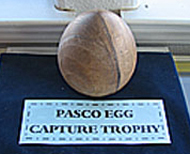Going after the Egg - A little background
If you're from region 11, you may know about the PASCO Egg regional capture trophy. A beautiful walnut (I think) egg that is occasionally captured from various glider operations mostly in Northern California and Nevada. It has been a goal of mine to try and capture the Egg for Avenal from what has practically become it's permanent home at Air Sailing. Our neighbors to the north at Hollister also have their eye on that prize, but we have the Central Valley and the Sierra Nevada mountains in between us and our trophy. That and nearly 300 miles. Once the Hollister crew and I realized we had the same secret goal, we began to share information on tactics and approaches. There are really only two options when it comes to the Sierra Nevada. Go over or go around.
Going over the Sierra has all sorts of challenges and intimidation, but the first problem is crossing the massive San Joaquin Valley. The typical summer weather pattern that would give high enough climbs and cloudbases on the Sierra also happens to produce a nasty inversion in the valley at 2000 feet or so. Many an attempt at crossing to the Sierras have failed with pilots circling at pattern level over airports near the foothills in 100+ heat. Able to stay up, but unable to climb and proceed.
Going around the Sierra involves running south to the Tehachapi range and then transitioning into the Sierra's along their trade routes. The same valley inversion can be a problem, though usually it is 4-5k over at Avenal. That and you are adding several hundred miles to your journey by heading south first, but a good convergence and high enough altitudes and a speed run is possible that makes the journey an option during the long days of summer.
Heading into the July 4th weekend conditions were lining up for some long distances out of the Great Basin. Doug Armstrong was alerting pilots to booming conditions to come. Matt Gillis out of Hollister and Darren Braun started piping up about the approaching weather pattern, a four corners high retrograding to the west. Kempton Izuno out of Williams Soaring was getting things lined up for long flights. It sounded like it was going to be a good weekend to make a strike. If you can't understand the complexities of the weather, at least find people you can count on and follow their lead.
Heading into the weekend, I needed three things. A tow pilot, cooperative weather and a crew. Weather forecasts were faltering a bit, but it looked like Sunday could be a day for an attempt. Monday was looking to have an issue with thunderstorms coming in from the south, but higher cloudbases. I coerced Steve into towing on Sunday by offering him a seat in the Duo on Saturday so he'd at least get to fly a glider with his safely hangared in New Mexico for the summer. For crew, my old hang gliding buddy Keith had extended the offer that if I ever needed a crew for an adventure, he was in. A double and triple check of the offer confirmed that the weekend was a go.
One thing I've found with the Duo and especially when trying to fill a seat is that you need to cast a wide net and then disappoint a few people. Try to find a copilot in a serial fashion and you'll find yourself with an empty seat as your launch day approaches. So by Friday, I was giving Alex and Bart the bad news that Matt Gillis was going to be occupying the spare seat. He's been invaluable in thinking through the weather paradigms that are involved in this kind of attempt. It seemed like he'd be the perfect copilot on the adventure.
Saturday at Avenal was pretty blah. Hot and low, Steve and I managed to climb to 5k once, but generally were limited to about 4k at the most. 4k isn't really enough to even get comfortably over the mountains to the southwest and on to the next duster strip near Shandon. Not looking too good for Sunday's attempt.

 Alex Caldwell's RASPs were showing a convergence line well to the South over the La Panza range, but not much over 4k to be expected for the first 40 miles from Avenal. Once on the La Panza range the conditions looked like they should steadily improve to 10k+ near New Cuyama and then 13-15k by Frazier Park and beyond Tehachapi into the Sierra. Looks good, just that first 70-80 miles will be tough and slow.
Alex Caldwell's RASPs were showing a convergence line well to the South over the La Panza range, but not much over 4k to be expected for the first 40 miles from Avenal. Once on the La Panza range the conditions looked like they should steadily improve to 10k+ near New Cuyama and then 13-15k by Frazier Park and beyond Tehachapi into the Sierra. Looks good, just that first 70-80 miles will be tough and slow.Matt and I synced up late on Saturday about logistics and a general plan we had both come to separately. We'd take a high tow towards Shandon, release and then glide south towards Camatta, a usable airstrip near the La Panza range. That should connect us with the heat and hopefully the convergence, then it was just a matter of linking paradigms. Coastal influenced airmasses, the convergence zone of the Tehachapi's and then into the Sierra's, gateway to the Great Basin.
The Duo was set up and ready to go. Extra water stowed, batteries fully charged, oxygen ready, backup radio and gps options. It was go time.
The Attempt



Comments